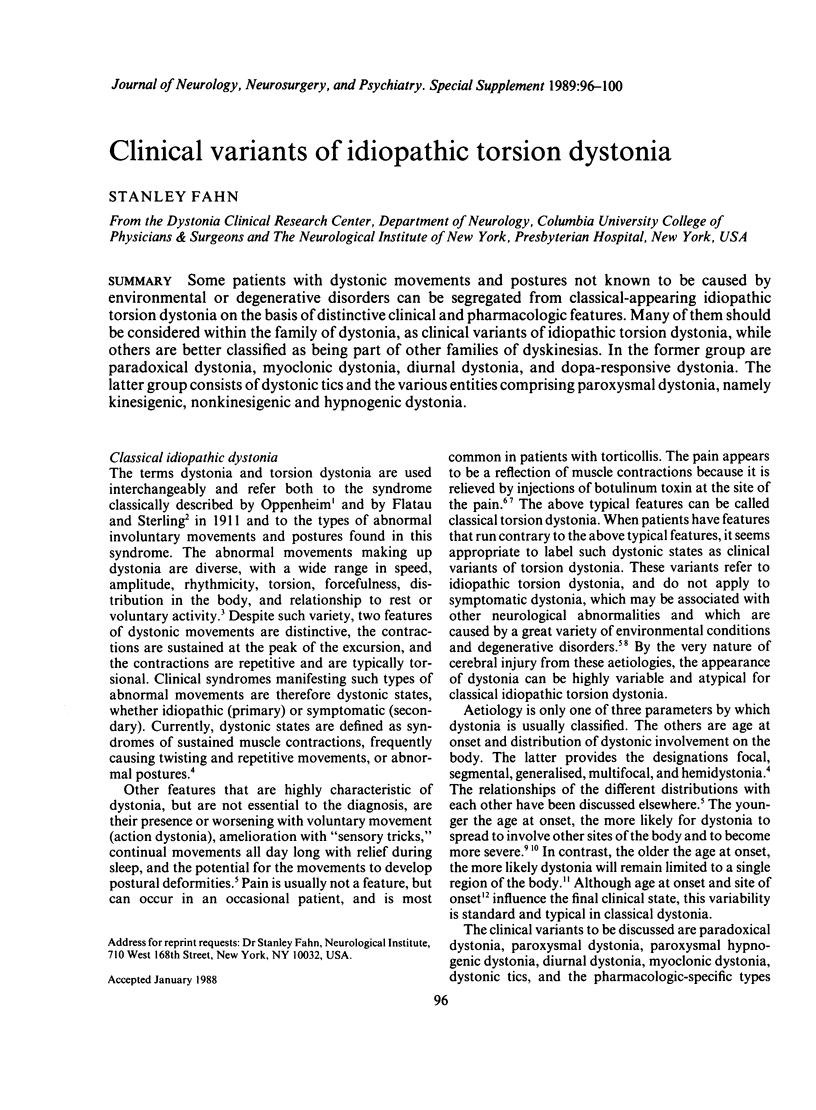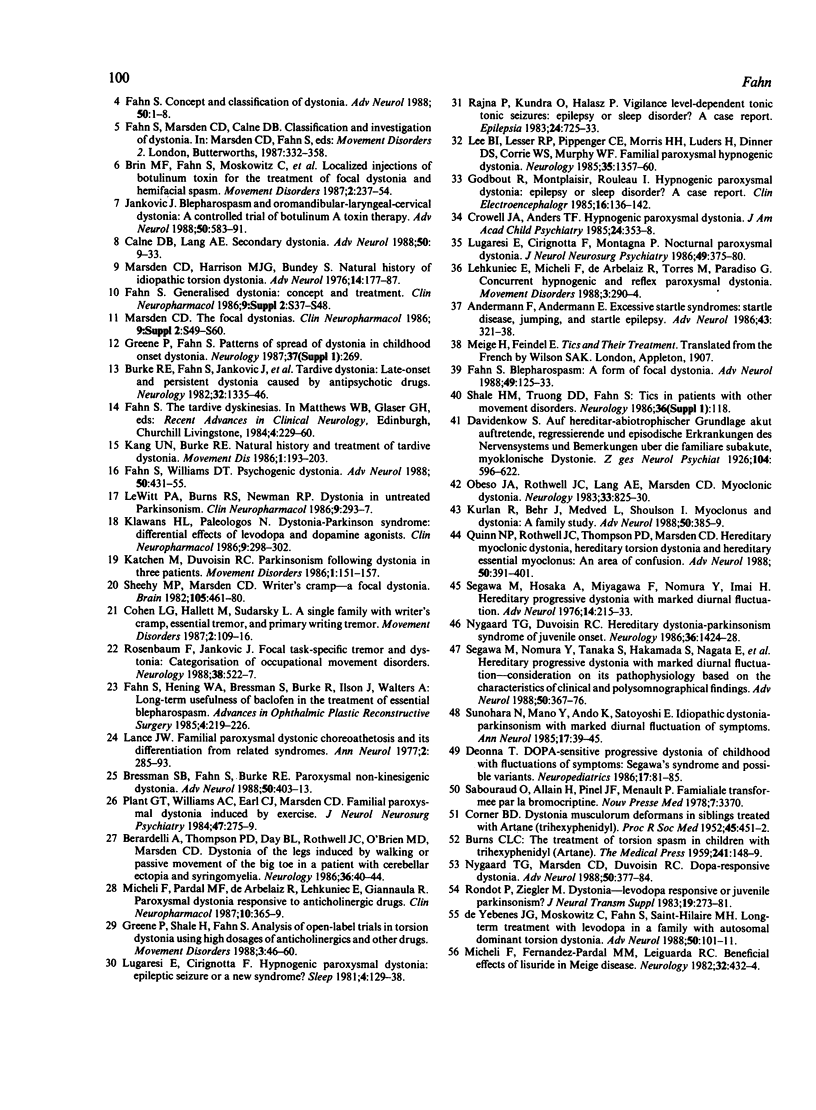Abstract
Some patients with dystonic movements and postures not known to be caused by environmental or degenerative disorders can be segregated from classical-appearing idiopathic torsion dystonia on the basis of distinctive clinical and pharmacologic features. Many of them should be considered within the family of dystonia, as clinical variants of idiopathic torsion dystonia, while others are better classified as being part of other families of dyskinesias. In the former group are paradoxical dystonia, myoclonic dystonia, diurnal dystonia, and dopa-responsive dystonia. The latter group consists of dystonic tics and the various entities comprising paroxysmal dystonia, namely kinesigenic, nonkinesigenic and hypnogenic dystonia.
Full text
PDF




Selected References
These references are in PubMed. This may not be the complete list of references from this article.
- Andermann F., Andermann E. Excessive startle syndromes: startle disease, jumping, and startle epilepsy. Adv Neurol. 1986;43:321–338. [PubMed] [Google Scholar]
- Berardelli A., Thompson P. D., Day B. L., Rothwell J. C., O'Brien M. D., Marsden C. D. Dystonia of the legs induced by walking or passive movement of the big toe in a patient with cerebellar ectopia and syringomyelia. Neurology. 1986 Jan;36(1):40–44. doi: 10.1212/wnl.36.1.40. [DOI] [PubMed] [Google Scholar]
- Bressman S. B., Fahn S., Burke R. E. Paroxysmal non-kinesigenic dystonia. Adv Neurol. 1988;50:403–413. [PubMed] [Google Scholar]
- Brin M. F., Fahn S., Moskowitz C., Friedman A., Shale H. M., Greene P. E., Blitzer A., List T., Lange D., Lovelace R. E. Localized injections of botulinum toxin for the treatment of focal dystonia and hemifacial spasm. Mov Disord. 1987;2(4):237–254. doi: 10.1002/mds.870020402. [DOI] [PubMed] [Google Scholar]
- Burke R. E., Fahn S., Jankovic J., Marsden C. D., Lang A. E., Gollomp S., Ilson J. Tardive dystonia: late-onset and persistent dystonia caused by antipsychotic drugs. Neurology. 1982 Dec;32(12):1335–1346. doi: 10.1212/wnl.32.12.1335. [DOI] [PubMed] [Google Scholar]
- CORNER B. D. Dystonia musculorum deformans in siblings; treated with artane (trihexyphenidyl). Proc R Soc Med. 1952 Jul;45(7):451–452. doi: 10.1177/003591575204500710. [DOI] [PMC free article] [PubMed] [Google Scholar]
- Calne D. B., Lang A. E. Secondary dystonia. Adv Neurol. 1988;50:9–33. [PubMed] [Google Scholar]
- Cohen L. G., Hallett M., Sudarsky L. A single family with writer's cramp, essential tremor, and primary writing tremor. Mov Disord. 1987;2(2):109–116. doi: 10.1002/mds.870020205. [DOI] [PubMed] [Google Scholar]
- Crowell J. A., Anders T. F. Hypnogenic paroxysmal dystonia. J Am Acad Child Psychiatry. 1985 May;24(3):353–358. doi: 10.1016/s0002-7138(09)61098-0. [DOI] [PubMed] [Google Scholar]
- Deonna T. DOPA-sensitive progressive dystonia of childhood with fluctuations of symptoms--Segawa's syndrome and possible variants. Results of a collaborative study of the European Federation of Child Neurology Societies (EFCNS). Neuropediatrics. 1986 May;17(2):81–85. doi: 10.1055/s-2008-1052506. [DOI] [PubMed] [Google Scholar]
- Fahn S. Blepharospasm: a form of focal dystonia. Adv Neurol. 1988;49:125–133. [PubMed] [Google Scholar]
- Fahn S. Concept and classification of dystonia. Adv Neurol. 1988;50:1–8. [PubMed] [Google Scholar]
- Fahn S. The varied clinical expressions of dystonia. Neurol Clin. 1984 Aug;2(3):541–554. [PubMed] [Google Scholar]
- Fahn S., Williams D. T. Psychogenic dystonia. Adv Neurol. 1988;50:431–455. [PubMed] [Google Scholar]
- Godbout R., Montplaisir J., Rouleau I. Hypnogenic paroxysmal dystonia: epilepsy or sleep disorder? A case report. Clin Electroencephalogr. 1985 Jul;16(3):136–142. doi: 10.1177/155005948501600307. [DOI] [PubMed] [Google Scholar]
- Greene P., Shale H., Fahn S. Analysis of open-label trials in torsion dystonia using high dosages of anticholinergics and other drugs. Mov Disord. 1988;3(1):46–60. doi: 10.1002/mds.870030107. [DOI] [PubMed] [Google Scholar]
- Jankovic J. Blepharospasm and oromandibular-laryngeal-cervical dystonia: a controlled trial of botulinum A toxin therapy. Adv Neurol. 1988;50:583–591. [PubMed] [Google Scholar]
- Kang U. J., Burke R. E., Fahn S. Natural history and treatment of tardive dystonia. Mov Disord. 1986;1(3):193–208. doi: 10.1002/mds.870010305. [DOI] [PubMed] [Google Scholar]
- Katchen M., Duvoisin R. C. Parkinsonism following dystonia in three patients. Mov Disord. 1986;1(2):151–157. doi: 10.1002/mds.870010210. [DOI] [PubMed] [Google Scholar]
- Klawans H. L., Paleologos N. Dystonia-Parkinson syndrome: differential effects of levodopa and dopamine agonists. Clin Neuropharmacol. 1986;9(3):298–302. [PubMed] [Google Scholar]
- Kurlan R., Behr J., Medved L., Shoulson I. Myoclonus and dystonia: a family study. Adv Neurol. 1988;50:385–389. [PubMed] [Google Scholar]
- Lance J. W. Familial paroxysmal dystonic choreoathetosis and its differentiation from related syndromes. Ann Neurol. 1977 Oct;2(4):285–293. doi: 10.1002/ana.410020405. [DOI] [PubMed] [Google Scholar]
- LeWitt P. A., Burns R. S., Newman R. P. Dystonia in untreated parkinsonism. Clin Neuropharmacol. 1986;9(3):293–297. doi: 10.1097/00002826-198606000-00007. [DOI] [PubMed] [Google Scholar]
- Lee B. I., Lesser R. P., Pippenger C. E., Morris H. H., Lüders H., Dinner D. S., Corrie W. S., Murphy W. F. Familial paroxysmal hypnogenic dystonia. Neurology. 1985 Sep;35(9):1357–1360. doi: 10.1212/wnl.35.9.1357. [DOI] [PubMed] [Google Scholar]
- Lehkuniec E., Micheli F., De Arbelaiz R., Torres M., Paradiso G. Concurrent hypnogenic and reflex paroxysmal dystonia. Mov Disord. 1988;3(4):290–294. doi: 10.1002/mds.870030402. [DOI] [PubMed] [Google Scholar]
- Lugaresi E., Cirignotta F. Hypnogenic paroxysmal dystonia: epileptic seizure or a new syndrome? Sleep. 1981;4(2):129–138. doi: 10.1093/sleep/4.2.129. [DOI] [PubMed] [Google Scholar]
- Lugaresi E., Cirignotta F., Montagna P. Nocturnal paroxysmal dystonia. J Neurol Neurosurg Psychiatry. 1986 Apr;49(4):375–380. doi: 10.1136/jnnp.49.4.375. [DOI] [PMC free article] [PubMed] [Google Scholar]
- Marsden C. D., Harrison M. J., Bundey S. Natural history of idiopathic torsion dystonia. Adv Neurol. 1976;14:177–187. [PubMed] [Google Scholar]
- Marsden C. D. The focal dystonias. Clin Neuropharmacol. 1986;9 (Suppl 2):S49–S60. [PubMed] [Google Scholar]
- Micheli F., Fernandez Pardal M., de Arbelaiz R., Lehkuniec E., Giannaula R. Paroxysmal dystonia responsive to anticholinergic drugs. Clin Neuropharmacol. 1987 Aug;10(4):365–369. doi: 10.1097/00002826-198708000-00007. [DOI] [PubMed] [Google Scholar]
- Micheli F., Fernández Pardal M. M., Leiguarda R. C. Beneficial effects of lisuride in Meige disease. Neurology. 1982 Apr;32(4):432–434. doi: 10.1212/wnl.32.4.432. [DOI] [PubMed] [Google Scholar]
- Nygaard T. G., Duvoisin R. C. Hereditary dystonia-parkinsonism syndrome of juvenile onset. Neurology. 1986 Nov;36(11):1424–1428. doi: 10.1212/wnl.36.11.1424. [DOI] [PubMed] [Google Scholar]
- Nygaard T. G., Marsden C. D., Duvoisin R. C. Dopa-responsive dystonia. Adv Neurol. 1988;50:377–384. [PubMed] [Google Scholar]
- Obeso J. A., Rothwell J. C., Lang A. E., Marsden C. D. Myoclonic dystonia. Neurology. 1983 Jul;33(7):825–830. doi: 10.1212/wnl.33.7.825. [DOI] [PubMed] [Google Scholar]
- Plant G. T., Williams A. C., Earl C. J., Marsden C. D. Familial paroxysmal dystonia induced by exercise. J Neurol Neurosurg Psychiatry. 1984 Mar;47(3):275–279. doi: 10.1136/jnnp.47.3.275. [DOI] [PMC free article] [PubMed] [Google Scholar]
- Quinn N. P., Rothwell J. C., Thompson P. D., Marsden C. D. Hereditary myoclonic dystonia, hereditary torsion dystonia and hereditary essential myoclonus: an area of confusion. Adv Neurol. 1988;50:391–401. [PubMed] [Google Scholar]
- Rajna P., Kundra O., Halász P. Vigilance level-dependent tonic seizures--epilepsy or sleep disorder? A case report. Epilepsia. 1983 Dec;24(6):725–733. doi: 10.1111/j.1528-1157.1983.tb04635.x. [DOI] [PubMed] [Google Scholar]
- Rondot P., Ziegler M. Dystonia--L-dopa responsive or juvenile parkinsonism? J Neural Transm Suppl. 1983;19:273–281. [PubMed] [Google Scholar]
- Rosenbaum F., Jankovic J. Focal task-specific tremor and dystonia: categorization of occupational movement disorders. Neurology. 1988 Apr;38(4):522–527. doi: 10.1212/wnl.38.4.522. [DOI] [PubMed] [Google Scholar]
- Sabouraud O., Allain H., Pinel J. F., Menault F. Dystonie familiale transformée par la bromocriptine. Nouv Presse Med. 1978 Oct 28;7(37):3370–3370. [PubMed] [Google Scholar]
- Segawa M., Hosaka A., Miyagawa F., Nomura Y., Imai H. Hereditary progressive dystonia with marked diurnal fluctuation. Adv Neurol. 1976;14:215–233. [PubMed] [Google Scholar]
- Segawa M., Nomura Y., Tanaka S., Hakamada S., Nagata E., Soda M., Kase M. Hereditary progressive dystonia with marked diurnal fluctuation--consideration on its pathophysiology based on the characteristics of clinical and polysomnographical findings. Adv Neurol. 1988;50:367–376. [PubMed] [Google Scholar]
- Sheehy M. P., Marsden C. D. Writers' cramp-a focal dystonia. Brain. 1982 Sep;105(Pt 3):461–480. doi: 10.1093/brain/105.3.461. [DOI] [PubMed] [Google Scholar]
- Sunohara N., Mano Y., Ando K., Satoyoshi E. Idiopathic dystonia-parkinsonism with marked diurnal fluctuation of symptoms. Ann Neurol. 1985 Jan;17(1):39–45. doi: 10.1002/ana.410170110. [DOI] [PubMed] [Google Scholar]
- de Courten-Myers G., Mandybur T. I. Atypical Gerstmann-Straüssler syndrome or familial spinocerebellar ataxia and Alzheimer's disease? Neurology. 1987 Feb;37(2):269–275. doi: 10.1212/wnl.37.2.269. [DOI] [PubMed] [Google Scholar]
- de Yebenes J. G., Moskowitz C., Fahn S., Saint-Hilaire M. H. Long-term treatment with levodopa in a family with autosomal dominant torsion dystonia. Adv Neurol. 1988;50:101–111. [PubMed] [Google Scholar]


